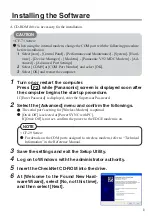
INTEL TURBO BOOST TECHNOLOGY
*
Intel Turbo Boost is a feature that speeds up the CPU for a short time. It is similar to overclocking the processor, except within a
framework provided by Intel. This feature provides additional performance and allows the computer to perform certain tasks
more quickly. It also draws additional power and generates additional heat. Therefore, if Turbo Boost is used while powered from
battery, it causes additional stress on the battery.
Using Turbo Boost while powered from battery might impact battery cycle life. Cycle life describes how long the battery will last
before it needs to be replaced. A cycle refers to one complete charge/discharge cycle of the battery. Because Turbo Boost causes
extra stress on the battery, it often shortens the lifetime of the battery.
HP decided not to enable Turbo Boost when powered from battery. This decision was based on the desire to give customers the
greatest battery cycle life possible. Turbo Boost is enabled when powered from AC adapter.
Based on customer requests, HP will provide an option to enable Turbo Boost while powered from battery. For the 2013 platform,
it will be an F10 option. Turbo Boost will be available for devices powered from battery by the end of the year. The additional
performance might cause a slight reduction in battery cycle life, but will not void the battery warranty.
*Implementing Turbo Boost in F10 option is only allowed for batteries over 40WHr.
CHIPSET
Mobile Intel® HM87 or QM87
INTEL CORE I5 WITH VPRO/CORE I7 WITH VPRO TECHNOLOGY CAPABLE
Intel Core i5 with vPro and Core i7 with vPro technology is a selectable feature that is available on units configured with select
processors, an Intel Centrino® Advanced-N or Ultimate-N WLAN module and a preinstalled Windows operating system. It provides
advances in remote manageability, security, energy efficient performance, and wireless connectivity. Intel Active Management
Technology 9.0 (iAMT) offers built-in manageability and proactive security for networked notebook PCs, even when they are
powered off
*
or when the operating system is inoperable. It can help identify threats before they reach the network, isolate
infected systems, and update PCs regardless of their power state.
*Requires a Windows operating system, network hardware and software, connection with a power source, and a direct (non-VPN)
corporate network connection which is either cable or wireless LAN.
NOTE: Some functionality of this technology, such as Intel® Active management technology and Intel Virtualization technology,
requires additional 3rd party software in order to run. Availability of future "virtual appliances" applications for Intel vPro
technology is dependent on 3rd party software providers. Microsoft Windows required. For hard drives, GB = 1 billion bytes. Actual
formatted capacity is less. Up to 30 GB for Windows 8 is reserved for system recovery software.
QuickSpecs
HP ProBook 640 G1 Notebook PC
HP ProBook 650 G1Notebook PC
Features
DA - 14688 Worldwide — Version 8 — March 17, 2014
Page 9










































